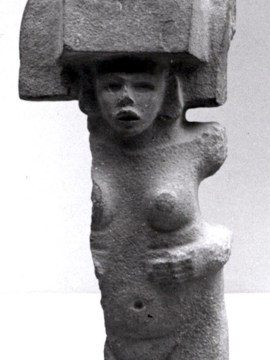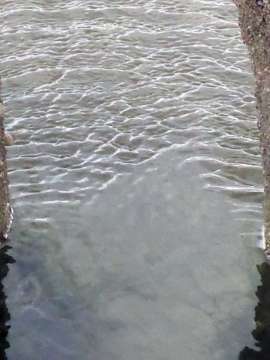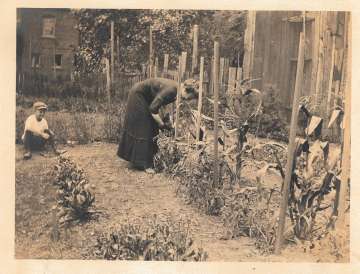Learning to Forget: Seeking balance between science and fiction
Donna Mazza
I am not a scientist; I was a reasonable biology student, but I limped through chemistry at high school and eventually dropped it for politics. My school learning of science calcified when I chose to focus on arts at university, but when I conceived the premise of Fauna, I drew back the curtains on science for the sake of writing and became a student of the ‘intermezzo’: the in-between of science and fiction and the in-between of human and Neanderthal.
CRISPR system Cascade protein subunits CasA, CasB, CasC, CasD, and CasE (cyan) bound to CRISPR RNA (green) and viral DNA (red) based on PDB 4QYZ and rendered with PyMOL. image by Boghog - Own work, CC BY-SA 4.0
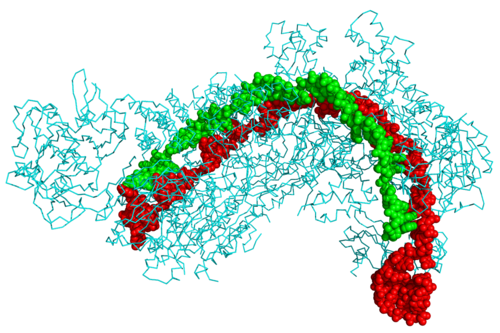
Lured by articles in National Geographic on de-extinction, I began researching CRISPR and its exciting potential to revive species like the mammoth, thylacine and passenger pigeon. CRISPR/Cas9 is a ground-breaking gene editing tool that allows relatively long fragments of DNA and RNAs to be precisely inserted into the genome sequence at one time. This means the process of genetic engineering is quicker and more viable. The idea that this technology might be used on reviving extinct humans was one I arrived at myself and I wrote a short story about it, “The Exhibit”, published in 2015 .
This story takes a feminist approach to emerging genetic technology through the perspective of a woman who is recruited to carry a hybrid human-Neanderthal foetus. Unknown to me at the time, Harvard geneticist George Church had called for future female volunteers to gestate a cloned Neanderthal and caused a sensation.
The short story could not explore this idea this deeply enough, and the embryo of a novel continued to grow. Through writing “The Exhibit”, I realised the nature of humanness was not inviolable, and technology to change the human genome is now in our hands. I wanted to know more about what this experience might be like and to sink into the reality of it. I wanted to feel the truth of it and explore the moral dilemma it presents. What if this was happening to a real mother? Because, for this to happen in our world, a real mother is required.
Nursing this into a novel, Fauna, published this year by Allen & Unwin, involved much wider research because I wanted the Neanderthal child to be born in the novel. My ‘what ifs?’ grew exponentially and ideas from different disciplines began to cross pollinate. Story and science bled into one another, leading me into other areas of research. I learned from work in microbiology, paleogenetics and archaeology and built my language around pregnancy and the technologies now used to support it, as well as human and primate development. I learned that Neanderthal people had a larynx much like ours, so they probably spoke; that the bacteria on their teeth showed they ate mushrooms, nuts and used medicinal herbs to treat illnesses. I used a drawing of Neanderthal baby-teeth to plot weaning and spent some time working out the discomforting mechanics of birth and head circumference. For years, I immersed myself in a weird mix of scientific texts, podcasts, journal articles and news stories, mapping out what the conception, pregnancy, birth and childhood of a Neanderthal child might be like, including how the medical profession might monitor a high risk pregnancy in the future. I also came up with the idea of a micro camera in-utero which connects in real time to give a live feed and called it PregCam™. This body of knowledge underpins Fauna. But the novel is not a science book.
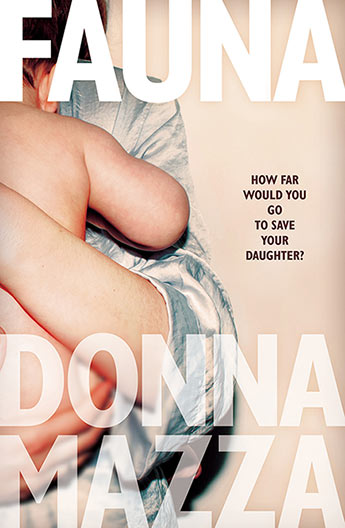
Immersion in science provides the writer with language and concepts that work as a scaffold. But this knowledge needs to be, in part at least, forgotten before a convincing and engaging human story can be told. Humanist science fiction takes the human experience as the central focus of the narrative, and although the story may be set in a sci-fi ‘world,’ the scientific is a secondary concern (Mann, 2001, p.490). The story for my Neanderthal character and her mother is an emotional one, and empathy is at its core.
To hone the skill of letting go of science, I worked on putting this into practice through short fiction. A segment on ABC Radio National’s The Science Show led me to write a story about limb regeneration, and I experimented with strategies for presenting this scientific speculation: what if a real human tail could be generated, and this became body art? “The True Tail™” (2019) took me four years and nine drafts to get ‘right’ as I weeded out the science so the story could take priority. Early drafts provide a lot of background to the premise and justify the science in the story: For example, early attachment trials involved growing human tissue around a plastic armature and using skin grafts to anchor the fleshy sausage to the coccyx. The chimp who wore this early appendage was unimpressed and eventually bit it off.
I tried not to waste my research, but I also felt the burden-of-proof, particularly as a non-scientist. I wanted to demonstrate that I knew the scientific content, but in the end I hit ‘delete’ on all of it, liberating the story, and the reader, from a weighty burden of facts, very much in keeping with what Virginia Woolf disliked in the work of HG Wells and others of his era.
In her 1921 essay “Modern Fiction”, Virginia Woolf berates what she calls ‘materialist’ writers such as Wells who “spend immense skill and immense industry making the trivial and the transitory appear the true and the enduring”. She accuses them of creating their characters through describing “every last button of their coats” at the expense of depicting life. What she asks of modern fiction is to ignore the buttons, telling us that “life is not a series of gig-lamps symmetrically arranged; life is a luminous halo, a semi-transparent envelope surrounding us from the beginning of consciousness to the end.” The task of the writer is not to get buried in the detail of the material world but to “convey this varying, this unknown and uncircumscribed spirit, whatever aberration or complexity it may display”.
The narrative of science is driven by the scientific method and the narrative of fiction is more of a “semi-transparent envelope”; a portal into the secret vaults of human consciousness.
It is hard to let go of the research and the facts but my intention in writing about the science of human de-extinction was to excavate what a lived experience might be for the humans involved. I wanted my reader to contemplate what this technology may bring to a mother, a child and her family if (or when) it happens. I wanted it to seem real. After the labour pains of my ‘Tail’ story, I spurned the didactic informative voice and sought instead an empathic human one, complete with flaws and vices.
Finding a balance between scientific language and human experience is one of the key strategies to bring these two, somewhat opposing forces together. Through my short story apprenticeship, I developed a strategy for putting the jargon into the voice of the medical and scientific professionals. In Fauna, the narrator has a very ordinary education and her focus is on her family and emotional landscape. This put scientific information in the voice of those figures in the story who manipulate scientific codes and allowed the narrator, Stacey, to interpret and understand it through her own lens and express it in her own language.
Stacey filters the science through her observation of the ‘real’ consequences. She shows us how it feels to be pregnant with a de-extincted Neanderthal baby, to surrender her body to a PregCam™ observing her baby in utero, to watch her experimental child, Asta, grow and to anticipate letting her go. At no point does Stacey refer to herself as a science experiment, yet the reader knows that she is also the subject of study.
Trusting the reader to fill in the gaps is an important balance to strike in fiction. What gaps they fill and what interpretation they make is subjective, but an author of fiction must assume that the reader will imagine the “buttons” without a prescription of every element of the fictional world. It is important for a writer of fiction drawing on scientific premise to understand this, and to avoid using a story as a teaching tool. Jules Verne’s novels are filled with lengthy descriptions of marine biology and other sciences aimed at 19th century French schoolchildren. These classic works have not aged well.
A reader does not need to know everything, but they need to know enough to suspend their disbelief. The role of the writer is to provoke the reader to think; it’s important to resist the temptation to tell too much. This is not something that merges smoothly with scientific method because it invites multiple interpretations, but this is what makes literary speculative fiction a potent force for our times: it resists dualism. It is not science and it is not entirely fiction.
Philosophers Deleuze and Guattari explore this in some depth, also citing Woolf; they speak directly to the puzzle faced by the writer of fiction informed by science when they say “the only way to get outside the dualisms is to be between, to pass between, the intermezzo”. They use the prefix “becoming” to provide a sense of the evolution and process involved with navigating the in-between space. I am a becoming-scientist and (always) a becoming-fiction writer. There is never a place of arrival but always a place of seeking.
The intermezzo is a gap between two disciplines, and they don’t play from the same songbook. There is no bridge to navigate the in-between of science and fiction because each story that springs from scientific concepts demands that its author orchestrate the two disciplines in original ways. It is important to respect the knowledge but also to allow it to be forgotten because the ‘what if’ of fiction needs to sift out grains of science and use them as seeds for dreaming. The author must occupy the space in-between. Like so many creative pursuits, this gap which seems emptiness is the place where creativity hits its peak, where the imagination really soars and unexpected disciplines, and species, are edited together.
Feature image via 'Art Collection - The Metropolitan Museum of Art'
